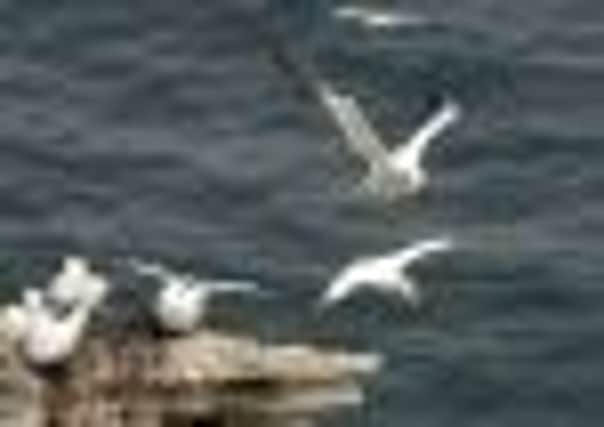A close eye for life on the edge


COME rain or come shine on the soaring chalk cliffs of Bempton, from the early months of the year until the autumn, Linda McKenzie sets up her telescope and checks on one of Yorkshire’s most precious populations.
Today, it’s raining, and the clouds coming in over the North Sea promise more of the same, but Linda is there, as she usually is on Tuesdays and Fridays, at the viewing platform at Staple Newk, the rocky outcrop that is one of the best places on the cliffs to watch some of the 17,000 or so gannets that spend many months of the year here.
Advertisement
Hide AdAdvertisement
Hide AdFor many of the 65,000-plus visitors to the RSPB’s Bempton Cliffs reserve, just north of Bridlington, the gannets are not the stars of the show that at its peak sees a quarter of a million seabirds on this stretch of the Yorkshire coast. That distinction belongs to the puffins, the little clown-faced bird that adults and children alike clamour to see for a few short months in spring and summer.


But for Linda, the gannets exert a much greater fascination, and that’s why, for the past six years, she’s volunteered to monitor their movements and breeding patterns, along the way opening the eyes of visitors to just what a spectacle lies before them.
It’s a very special and unusual population whose progress she charts – the only gannet colony in England, and one of only two on mainland Britain, the other being near Aberdeen, the next nearest colony only being accessible by boat on Bass Rock in the Firth of Forth.
The gannets are the most powerful native seabird, their black-tipped wings spanning six feet, their gleaming white plumage and buff-coloured head unmistakeable as they range 40 miles out to sea in search of mackerel or herring, diving into the water from 80ft up, and hitting the surface with their dagger-like bills at up to 60mph.
Advertisement
Hide AdAdvertisement
Hide AdThey set out on their quest in ones or twos, but return in small flocks, heading back to the cliffs with food for the young in a life cycle that begins at Bempton in February and runs through until October, when the adults depart for winter far out in the North Sea or North Atlantic and the young head for the west coast of Africa.
And for all those months, Linda is there to monitor them, her own holidays put on hold until the story of the gannets of the highest sea cliffs in England is over for another year.
It’s a long game for both birds and their monitor. Typically, the life of a gannet will span 20 to 25 years, and for the first five of those, the young hatched at Bempton will return there until maturity and breeding arrives, along with the distinctive plumage.
Linda, who lives in her home town on Scarborough, became involved in monitoring the gannets when she retired. She’s a familiar face on the reserve, and a tireless evangelist for the birds that fascinate her.
Advertisement
Hide AdAdvertisement
Hide Ad“It’s just a sort of funny reputation I’ve built up over the years because I do go on about gannets a bit,” she said. “They’re the biggest and best birds, and I think they’re the most interesting birds to watch. There’s a lot of behaviour between a pair of gannets that you can recognise and interpret. Gannets pair for life and come back to the same nest every year so there’s a lot of bonding behaviour.”
She first became interested in birdwatching while living in the Channel Islands, and it burgeoned when she returned home. With Bempton just about on her doorstep, and a fascination with the birds, who when paired fence with their bills like swords, Linda was asked if she would like to monitor their nests.
She began with 50 and now has 100. “I can look down at the top of the stack and know exactly where the 50 nests are,” said Linda. “Yu’ve got to be looking at the right bird at the right time to see what’s underneath it, and when the egg hatches it’s a tiny, naked black chick with a wobbly head like a ping pong ball, and again you’ve got to be quick to look under a bird and see if the egg’s hatched.”
Over the last couple of years, there have been two sessions electronically tagging 14 gannets to track their movements – a difficult operation involving climbing down the sheer faces of the chalk cliffs. Tricky though it was, it also gave the reserve the chance to install a carefully-camouflaged camera that relays live pictures of the gannet colony back to screens in the visitor centre.
Advertisement
Hide AdAdvertisement
Hide AdLinda is keen to share her knowledge with the visitors who come to the lookouts on the cliff top. “Quite a lot of people come and tell me, ‘We’re not really birdwatchers, you know’, and that’s all right, and I ask them if they’re enjoying looking at the birds, and they say yes, and then within a couple of minutes they’re telling you about all the birds in their garden. So I let them have their say, and then say, ‘You see, you are birdwatchers’. It’s just they’ve never seen seabirds before.”
“We get a lot of children at this time of year, and it’s surprising how knowledgeable some children are. If I can get the telescope low enough for a small child to use and they get an eye to it and I get an ‘Oh, wow’, or better still, ‘Cool’, I know they’ve been suitabl;y impressed.
“But adults do that as well, of course. If you look through a telescope and see a gannet’s head close up, that definitely deserves an ‘Oh, wow’.”
Visit www.rspb.org.uk/reserves/guide/b/bemptoncliffs